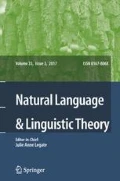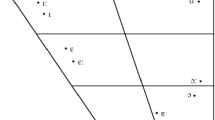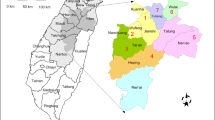Abstract
This paper explores morphologically-conditioned alternations in Mbat (Jarawan Bantu) verb stems. Some inflectional affixation in Mbat results in resyllabification. The singleton coda of a CGVC verb stem will become the onset of a new syllable following the addition of a vowel-initial suffix (e.g., Perfective -am). What is surprising is that this, in turn, triggers onset simplification in the stem itself (i.e., CV.C-am). Adding further complexity to Mbat is that these alternations are limited to verb stems containing mid vowels. Stems with low vowels retain their pre-vocalic glide upon suffixation (i.e., CGV.C-am). These outcomes have implications for at least two contemporary lines of inquiry in phonological theory: i) the prosodification and behavior of pre-vocalic glides, and ii) the formal connection between so-called M2 syllable margin positions (i.e., the second member of a complex onset and the sole member of a singleton coda). I illustrate that Mbat has something to contribute to current perspectives on both these fronts. In addition to the theoretical and typological contributions entailed herein, this paper is also significant in that it is the first formal linguistic study of a Jarawan Bantu language, a cluster of languages spoken primarily in eastern Nigeria.
Similar content being viewed by others
Notes
Loss of the onset glide also entails an alternation in the quality of the stem vowel, but its length does not alternate. I illustrate below that such alternations arise due to a ban against adjacent [+high] segments. Data suggest that Mbat’s mid vowels [ε] and [ɔ] are allophones of high vowel phonemes that appear only after an onset glide.
The identity of the Jarawa variety called “Jaar” by Gerhardt is unclear. This is because the term Jaar (or Jar) is used locally by speakers of several Jarawan varieties to refer to their language (see Maddieson and Williamson 1975). Mbat shares some properties with Gerhardt’s “Jaar,” but they appear not to be the same variety.
A reviewer notes similarities to the opacity in secondary articulation before low vowels in Nupe, as famously discussed in Hyman (1970). Hyman argued that underlying high and mid vowels introduce secondary articulation effects (labialization and palatalization) on a preceding consonant, after which lax mid vowels are neutralized to low, thereby rendering their effects opaque. In Nupe, these secondary articulations are triggered on consonants preceding both underlying mid vowels and high vowels. However, only the outcomes involving lax mid vowels are rendered opaque by the later neutralization rule. Those involving high vowels and tense mid vowels remain transparent. If the same were applicable in Mbat, one would have to argue that despite high vowels presumably sharing the same backness feature that one might deem to be responsible for such secondary articulations, they would have to be exempt from triggering labialization and palatalization.
Syllable codas are particularly susceptible to allophonic changes. For example, alveolar consonants are subject to retroflexion/palatalization, and implosives are simplified to plain stops in syllable codas.
I have found just three CVV words in my database, none of which are verbs: pāā ‘gap between rocks,’
 ‘you (SG),’ and ʃíí ‘gentle.’
‘you (SG),’ and ʃíí ‘gentle.’A reviewer suggests that perhaps the substantive distinction here (and in the Habitual) is between the selection of -VC vs. -CV, with the third -C form derived from -VC and arising as a way to avoid vowel hiatus. Whether driven by stem shape or hiatus resolution, both approaches readily capture the facts at hand. It remains to be seen what other outcomes in Mbat will help to tease apart this particular analytical subtlety.
A reviewer asks about potential parallels between the alternation of glide+mid vowel sequences and high vowels in Mbat and the hiatus/diphthong alternations that occur in Spanish. Analyses of Spanish vowels and diphthongs in Hualde and Prieto (2002) and Chitoran and Hualde (2007) discuss alternations between high vowels and glides or otherwise between vowels in hiatus and diphthongs that are largely predicated on stress. Diphthongs are the default realization of a sequence of rising sonority vowels, but hiatus is maintained if the first vowel is stressed. It is difficult to draw clear parallels, as the same type of alternations that yield hiatus in Spanish do not obtain in Mbat. Indeed, there are no instances where hiatus is maintained in Mbat. Rather, there are CGV sequences and CV sequences, but no evidence of CV.V. One way to view the Mbat scenario along these lines, however, might be that retention of stem CGV vs. the alternation to CV in Mbat is predicated on whether the stem is stressed or not. However, if we assume that schwa is associated with being or becoming unstressed, the fact that the stem vowel ∼ schwa and suffixal vowel ∼ schwa alternations that I introduced in Sect. 2 can arise in both a stem and a suffix in stems of the same shape under the same morphological conditions is problematic. The conditions on whether schwa appears in one location or the other are predicated on the quality of the stem and suffixal vowels, and appear to have nothing to do with stress or the word’s metrical structure. It might be tempting to view the maintenance of CGVC as an indicator that the stem is stressed and that CV results upon suffixation and a subsequent shift in location of stress to the Perfective suffix. However, this perspective viewed alongside the facts about schwa alternations are not in support of one another.
As mentioned above, CGVC stems may be derived from historical /CV1V2C/ sequences. Work on the reconstruction of Proto-Bantu by Meeussen (1967, 1979) proposes that some verb stems contain a sequence of two vowels, which may be identical or non-identical. Hyman (2003) points out that non-identical vowel sequences may have had an intervening glide separating them at some point in history. In some cases, these sequences have been reconstructed as consisting of a locative CV “primary” root followed by a vowel-initial suffix. Synchronically, such vowel-vowel sequences are typically realized with the first of the two vowels as a glide. This may be applicable to Mbat. A comparison of reconstructions in the Bantu Lexical Reconstructions 3 (BLR3) database (www.africamuseum.be/en/research/discover/human_sciences/culture_society/blr; last accessed 16 March 2020) against my data reveals that there are CGVC stems in Mbat that have Proto-Bantu cognates both with identical vowels (cf. Mbat [
 ] ‘dream’ and Proto-Bantu *dóot) and with non-identical vowels (cf. Mbat [
] ‘dream’ and Proto-Bantu *dóot) and with non-identical vowels (cf. Mbat [ ] ‘plant seed’ and Proto-Bantu
] ‘plant seed’ and Proto-Bantu  ). Of course, not all items in my database have corresponding reconstructions in the BLR3, so I cannot explore this in further detail at the present time.
). Of course, not all items in my database have corresponding reconstructions in the BLR3, so I cannot explore this in further detail at the present time.A reviewer asks whether one should expect a similar condition to hold between M1 positions, i.e., whether the presence of complex codas of the shape YX]σ would formally imply the presence of singleton onset X. I am not aware of any detailed discussion of this in the published literature, but the same logic applied to M2 positions would also arguably hold here. A conjoined constraint on a coda cluster like *M2/Y&*M1/X]σ would still be ranked above its constituent constraints, including *M1/X, meaning that X would generally be expected as a potential singleton onset.
I am grateful to a reviewer for asking about what one might predict concerning the prosodification of the pre-vocalic glide in the non-suffixed form of (35d). At issue is that given the constraints currently under consideration, one might expect such a form to emerge with a light diphthong as [
 ], rather than retaining its glide in the onset as [kwāq]. I believe that it is reasonable to posit that a lower-ranked and more general constraint would choose in favor of [kwāq], the reason being that the impetus to prosodify a pre-vocalic glide into a light diphthong emerges as an alternative to satisfy the M2 licensing condition. Thus, one could argue that when no such ‘repair’ is necessary in unsuffixed CGaC stems, the alternative prosodification is not an optimal choice.
], rather than retaining its glide in the onset as [kwāq]. I believe that it is reasonable to posit that a lower-ranked and more general constraint would choose in favor of [kwāq], the reason being that the impetus to prosodify a pre-vocalic glide into a light diphthong emerges as an alternative to satisfy the M2 licensing condition. Thus, one could argue that when no such ‘repair’ is necessary in unsuffixed CGaC stems, the alternative prosodification is not an optimal choice.
References
Baertsch, Karen. 2002. An optimality theoretic approach to syllable structure: The split margin hierarchy. PhD dissertation, Indiana University, Bloomington.
Baertsch, Karen, and Stuart Davis. 2003. The split margin approach to syllable structure. ZAS Working Papers in Linguistics 32: 1–14.
Baertsch, Karen, and Stuart Davis. 2008. Decomposing the syllable contact asymmetry in Korean. In Asymmetries in phonology: An East-Asian perspective, ed. Haruo Kubozono, 27–47. Tokyo: Kurosio.
Baertsch, Karen, and Stuart Davis. 2009. Strength relations between consonants: A syllable-based OT approach. In Strength relations in phonology, eds. Kuniya Nasukawa and Phillip Backley, 293–324. New York: Mouton de Gruyter.
Blench, Roger. 2006. Jarawan Bantu: New data and its relation to Bantu. Unpublished ms.
Blench, Roger. 2015. The Bantoid languages. In Oxford handbooks online. https://doi.org/10.1093/ofrodhb/9780199935345.013.17.
Blevins, Juliette. 1995. The syllable in phonological theory. In The handbook of phonological theory, 206–244. Oxford: Blackwell.
Booij, Geert. 2011. Morpheme structure constraints. In The Blackwell companion to phonology, eds. Marc Van Oostendorp, Colin J. Ewen, Elizabeth Hume, and Keren Rice, 2049–2069. Hoboken: Wiley & Sons.
Cairns, Charles. 1988. Phonotactics, markedness, and lexical representation. Phonology 5: 209–236.
Cheon, Sang Yee. 2002. Glides as consonants in Korean. Language Research 38(2): 619–645.
Chitoran, Ioana, and José Ignacio Hualde. 2007. From hiatus to diphthong: The evolution of vowel sequences in Romance. Phonology 24(1): 37–75.
Clements, George N. 1990. The role of the sonority cycle in core syllabification. In Papers in laboratory phonology I: Between the grammar and physics of speech, eds. John Kingston and Mary Beckman, 283–333. New York: Cambridge University Press.
Clements, George N., and Samuel J. Keyser. 1983. CV phonology: A generative theory of the syllable. Cambridge: MIT Press.
Davis, Stuart. 1988. Topics in syllable geometry. New York: Garland.
Davis, Stuart, and Karen Baertsch. 2005. The diachronic link between onset clusters and codas. Annual Meeting of the Berkeley Linguistics Society (BLS) 31: 397–408.
Davis, Stuart, and Karen Baertsch. 2008. Implications of the Split Margin Approach to the syllable: The relationships between onset clusters and syllable contact sequences. Paper presented at the Congress of Linguists (CIL) 18, Seoul.
Davis, Stuart, and Karen Baertsch. 2011. On the relationship between codas and onset clusters. In Handbook of the syllable, eds. Charles E. Cairns and Eric Raimy, 71–95. Leiden: Brill.
Davis, Stuart, and Michael Hammond. 1995. On the status of onglides in American English. Phonology 12: 159–182.
Donegan, Patricia J. 1978. On the natural phonology of vowels. PhD dissertation, The Ohio State University.
Gerhardt, Ludwig. 1988. A note on verbal extensions in Jarawan Bantu. Journal of West African Languages 18(2): 3–8.
Goldsmith, John. 1976. Autosegmental Phonology. PhD dissertation, MIT.
Gouskova, Maria. 2004. Relational hierarchies in optimality theory: The case of syllable contact. Phonology 21(2): 201–250.
Green, Tonio. 2003. Extrasyllabic consonants and onset well-formedness. In The syllable in optimality theory, ed. Caroline Féry and Ruben van de Vijver, 238–253. Cambridge: Cambridge University Press.
Green, Christopher R., Stuart Davis, Boubacar Diakite, and Karen Baertsch. 2014. On the role of margin phonotactics in Colloquial Bamana complex syllables. Natural Language and Linguistic Theory 32(2): 499–536.
Grollemund, Rebecca. 2012. Nouvelles approches en classification: Application aux langues bantu du nord-ouest. PhD dissertation, Université Lumière Lyon 2.
Grollemund, Rebecca, and Jean-Marie Hombert. 2012. Sorting out the position of Bantu languages in Bantoid. Cameroon: Buea. Paper presented at the 7th World Congress on African Linguistics.
Hall, Tracy Alan. 2017. Underlying and derived glides in Middle High German. Glossa 2(1): 54.
Harris, James W., and Ellen M. Kaisse. 1999. Palatal vowels, glides, and obstruents in Argentinian Spanish. Phonology 16: 117–190.
Hualde, José Ignacio, and Mónica Prieto. 2002. On the diphthong/hiatus contrast in Spanish: Some experimental results. Linguistics 40(2): 217–234.
Hyman, Larry M. 1970. How concrete is phonology? Language 46: 58–76.
Hyman, Larry M. 2003. Segmental phonology. In The Bantu languages, eds. Derek Nurse and Gérard Philippson, 42–58. New York: Routledge.
Kaye, Jonathan D., and Jean Lowenstamm. 1981. Syllable structure and markedness theory. In Theory of markedness in generative grammar, eds. Adriana Belletti, Luciana Brandi, and Luigi Rizzi, 287–315. Philadelphia: Benjamins.
Kaye, Jonathan D., and Jean Lowenstamm. 1984. De la syllabicité. In Forme sonore du langage: Structure des représentations en phonologie, eds. François Dell, Daniel Hurst, and Jean-Roger Vergnaud, 123–159. Paris: Hermann.
Leben, William. 1973. Suprasegmental phonology. PhD dissertation, MIT.
Lindblom, Bjorn. 1986. Phonetic universals in vowel systems. In Experimental phonology, eds. John J. Ohala and Jeri J. Jaeger, 13–44. Orlando: Academic Press.
Maddieson, Ian, and Kay Williamson. 1975. Jarawan Bantu. African Languages 1: 125–163.
McCarthy, John J. 1995. Extensions of faithfulness: Rotuman revisited. Vol. 36 of Linguistics department faculty publication series. Amherst: University of Massachusetts.
McCarthy, John J. 2003. Comparative markedness. Theoretical Linguistics 29(1–2): 1–51.
Meeussen, Achille Emile. 1967. Bantu grammatical reconstructions. Africana Linguistica 3: 79–121.
Meeussen, Achille Emile. 1979. Vowel length in Proto-Bantu. Journal of African Languages and Linguistics 1: 1–7.
Miret, Fernando Sánchez. 1998. Some reflections on the notion of diphthong. Papers and Studies in Contrastive Linguistics 34: 27–51.
Nevins, Andrew, and Ioana Chitoran. 2008. Phonological representations and the variable patterning of glides. Lingua 118(12): 1979–1997.
Odden, David. 2015. Bantu phonology. In Oxford handbooks online. https://doi.org/10.1093/oxfordhb/9780199935345.013.59.
Padgett, Jaye. 2008. Glides, vowels, and features. Lingua 118(12): 1937–1955.
Prince, Alan, and Paul Smolensky. 1993/2004. Optimality theory: Constraint interaction in generative grammar. Malden: Blackwell.
Rosenthall, Samuel. 1994. Vowel/glide alternations in a theory of constraint interaction. PhD dissertation, University of Massachusetts, Amherst.
Selkirk, Elisabeth O. 1984. Phonology and syntax: The relation between sound and structure. Cambridge: MIT Press.
Smith, Jennifer L. 2012. The formal definition of the ONSET constraint and implications for Korean syllable structure. In Prosody matters: Essays in honor of Elisabeth Selkirk, eds. Toni Borowsky, Shigeto Kawahara, Takahito Shinya, and Mariko Sugahara, 73–108. London: Equinox.
Vennemann, Theo. 1972. On the theory of syllabic phonology. Linguistische Berichte 18: 1–18.
Vennemann, Theo. 1988. Preference laws for syllable structure and the explanation of sound change. Berlin: Mouton de Gruyter.
Weeda, Don. 1983. Perceptual and articulatory constraints on diphthongs in Universal Grammar. Texas Linguistic Forum 22: 147–162.
Yabilsu, J. Kulu. 1991. The phonology of Jar Galamkya dialect. MA thesis, University of Port Harcourt.
Zec, Draga. 2007. The syllable. In Handbook of phonology, ed. Paul de Lacy, 161–194. Cambridge: Cambridge University Press.
Acknowledgements
I am very grateful to Stuart Davis, Abbie Hantgan-Sonko, Deborah Morton, audience members at ACAL 50, three anonymous reviewers, and the NLLT editors for helpful feedback. I am indebted to Milkatu Garba for introducing me to Mbat and to Mr. Burga Kunkadma and the Tadnum Traditional Council in Bauchi State, Nigeria for their continued support of my research on Jarawan languages.
Author information
Authors and Affiliations
Corresponding author
Additional information
Publisher’s Note
Springer Nature remains neutral with regard to jurisdictional claims in published maps and institutional affiliations.
Rights and permissions
About this article
Cite this article
Green, C.R. On the link between onset clusters and codas in Mbat (Jarawan Bantu). Nat Lang Linguist Theory 39, 97–122 (2021). https://doi.org/10.1007/s11049-020-09469-9
Received:
Accepted:
Published:
Issue Date:
DOI: https://doi.org/10.1007/s11049-020-09469-9





 ‘you (SG),’ and ʃíí ‘gentle.’
‘you (SG),’ and ʃíí ‘gentle.’ ] ‘dream’ and Proto-Bantu *dóot) and with non-identical vowels (cf. Mbat [
] ‘dream’ and Proto-Bantu *dóot) and with non-identical vowels (cf. Mbat [ ] ‘plant seed’ and Proto-Bantu
] ‘plant seed’ and Proto-Bantu  ). Of course, not all items in my database have corresponding reconstructions in the BLR3, so I cannot explore this in further detail at the present time.
). Of course, not all items in my database have corresponding reconstructions in the BLR3, so I cannot explore this in further detail at the present time. ], rather than retaining its glide in the onset as [kwāq]. I believe that it is reasonable to posit that a lower-ranked and more general constraint would choose in favor of [kwāq], the reason being that the impetus to prosodify a pre-vocalic glide into a light diphthong emerges as an alternative to satisfy the M2 licensing condition. Thus, one could argue that when no such ‘repair’ is necessary in unsuffixed CGaC stems, the alternative prosodification is not an optimal choice.
], rather than retaining its glide in the onset as [kwāq]. I believe that it is reasonable to posit that a lower-ranked and more general constraint would choose in favor of [kwāq], the reason being that the impetus to prosodify a pre-vocalic glide into a light diphthong emerges as an alternative to satisfy the M2 licensing condition. Thus, one could argue that when no such ‘repair’ is necessary in unsuffixed CGaC stems, the alternative prosodification is not an optimal choice.